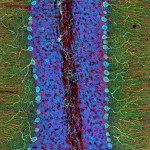Lien vers Pubmed [PMID] – 22685561
PLoS ONE 2012;7(6):e38336
BACKGROUND: Induction of Type I Interferon (IFN) genes constitutes an essential step leading to innate immune responses during virus infection. Sendai virus (SeV) infection of B lymphoid Namalwa cells transiently induces the transcriptional expression of multiple IFN-A genes. Although transcriptional activation of IFN-A genes has been extensively studied, the mechanism responsible for the attenuation of their expression remains to be determined.
PRINCIPAL FINDINGS: In this study, we demonstrate that virus infection of Namalwa cells induces transient recruitment of HDAC3 (histone deacetylase 3) to IFN-A promoters. Analysis of chromatin-protein association by Chip-QPCR demonstrated that recruitment of interferon regulatory factor (IRF)3 and IRF7, as well as TBP correlated with enhanced histone H3K9 and H3K14 acetylation, whereas recruitment of HDAC3 correlated with inhibition of histone H3K9/K14 acetylation, removal of IRF7 and TATA-binding protein (TBP) from IFN-A promoters and inhibition of virus-induced IFN-A gene transcription. Additionally, HDAC3 overexpression reduced, and HDAC3 depletion by siRNA enhanced IFN-A gene expression. Furthermore, activation of IRF7 enhanced histone H3K9/K14 acetylation and IFN-A gene expression, whereas activation of both IRF7 and IRF3 led to recruitment of HDAC3 to the IFN-A gene promoters, resulting in impaired histone H3K9 acetylation and attenuation of IFN-A gene transcription.
CONCLUSION: Altogether these data indicate that reversal of histone H3K9/K14 acetylation by HDAC3 is required for attenuation of IFN-A gene transcription during viral infection.

